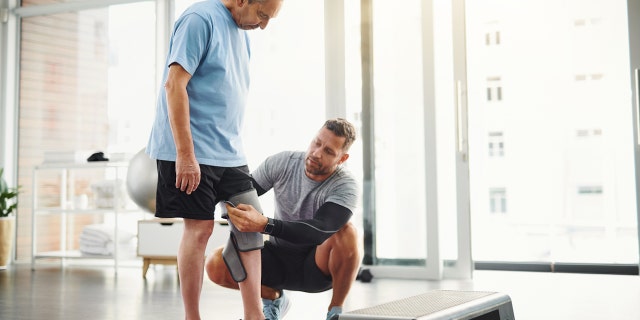About one in four U.S. adults has been diagnosed with arthritis, according to the CDC — and the knee is the joint that is most commonly affected.
With arthritis of the knee, the cartilage gradually breaks down until bone is rubbing directly on bone.
“When the bones in the knee joint rub together, it causes friction that makes the knees hurt, become stiff or swell,” said Dr. Nakul Karkare, a joint replacement surgeon at Complete Orthopedics in New York.
ASTHMA AND ECZEMA COULD INCREASE RISK OF OSTEOARTHRITIS, STUDY FINDS
Although there is no cure for arthritis, there are treatments that can relieve symptoms and slow the condition’s progress.
Fox News Digital spoke to the doctor, who shared six tips to help preserve the knees as long as possible after an arthritis diagnosis.
1. Maintain a healthy weight
The more you weigh, the more weight must be supported through your knees, said Karkare.

About one in four U.S. adults has been diagnosed with arthritis, per the CDC — and the knee is the joint that is most commonly affected. (iStock)
“This additional strain on your knees exacerbates arthritis symptoms,” he said. “Losing weight through a balanced diet and regular exercise can help relieve stress on your knees.”
2. Stay active
Arthritis can lead to a sedentary lifestyle, which can contribute to weight gain and increased pain, the doctor said.
To break this vicious cycle, he recommended trying low-impact exercises like swimming, cycling and walking.
THESE ADULT VACCINES COULD REDUCE SENIORS’ RISK OF ALZHEIMER’S, STUDY FINDS: ‘HEIGHTENED IMMUNE RESPONSE’
“These activities can help strengthen the muscles around your knees without putting excessive pressure on the joints,” he said.
“If cycling causes soreness in front of the knee, try moving the seat up to decrease the stress on the underside of the knee cap.”
Engaging in regular strength training can also help stabilize the knees, said Karkare.

Engaging in regular strength training can also help stabilize the knees, said Karkare. (iStock)
He said focusing on exercises that target the quadriceps, hamstrings and calf muscles can provide better support to the joint.
“Before exercising, make sure to warm up and perform gentle stretches,” the doctor suggested. “This can help improve flexibility and reduce the risk of injury.”
High-impact exercises such as running or jumping should be avoided, as these can worsen knee pain.
3. Use assistive devices and braces
Although many people resist using a cane due to associations with aging and disability, canes can benefit individuals with hip or knee pain, enhancing stability and comfort, the doctor said.
BE WELL: PREVENT DANGEROUS FALLS AMONG OLDER ADULTS BY TAKING KEY STEPS
He recommended using a cane on the opposite side of the affected joint, which will reduce pressure, aid movement and minimize pain flare-ups during activities like shopping.
Walkers and canes also help to prevent falls, while braces can correct flexible deformities and alleviate knee pain.
4. Choose supportive footwear
Wearing shoes with proper cushioning and arch support can help absorb shock and reduce strain on the knees, Karkare said.

Those with arthritis should try low-impact exercises like swimming, cycling and walking, said a joint replacement surgeon in New York. (Cyberguy.com)
“If you have flat feet, custom orthotics from your podiatrist will improve limb alignment,” he added.
5. Try injections for pain relief
There are two types of injections for arthritis pain relief: gel and cortisone.
Cortisone injections, which contain synthetic corticosteroids, swiftly reduce inflammation, said Karkare.
MOST SENIORS IN AMERICA CAN’T AFFORD NURSING HOMES OR ASSISTED LIVING, STUDY FINDS
In contrast, “gel” or “rooster comb” injections, which use hyaluronic acid, have a different mechanism of action — they are intended to alleviate joint pain and enhance mobility in osteoarthritis patients.
“While there is significant interest in injection using platelet-rich plasma and stem cells, further research is required to establish their effectiveness,” Karkare said.
“Moreover, these injections are not covered by insurance.”
6. Stay informed
When arthritis pain no longer responds to other treatments, Karkare said some newer, minimally invasive surgical techniques are available.

There are two types of injections for arthritis pain relief: gel and cortisone. (iStock)
“As an example, custom knee replacement is a surgical technique that involves replacing a damaged knee joint with a custom-designed implant through smaller incisions, minimizing tissue damage,” he said.
CLICK HERE TO SIGN UP FOR OUR HEALTH NEWSLETTER
“This approach aims to improve implant fit and alignment by using advanced imaging to create a personalized 3D model of the patient’s knee.”
The benefits of this procedure may include quicker recovery, reduced post-operative pain and potentially better long-term outcomes, he said.
Approximately 43% of people with osteoarthritis in the U.S. are 65 or older, while 88% are 45 or older, according to the Osteoarthritis Action Alliance.
For knee arthritis, however, the annual incidence is highest between 55 and 64 years old.
More than half of individuals with symptomatic arthritis of the knee are younger than 65.
To read more pieces in Fox News Digital’s “Be Well” series, click here.
Read More: World News | Entertainment News | Celeb News
